Management Accounting Report: Techniques, Planning, and Analysis
VerifiedAdded on 2022/12/23
|17
|3171
|49
Report
AI Summary
This report delves into the core concepts of management accounting, providing a comprehensive overview of various techniques and their applications. It explores microeconomic techniques, including cost analysis (fixed, variable, and cost-volume-profit), flexible budgeting, and cost variances. The report then examines product costing, encompassing fixed and variable costs, cost allocation, and different costing methods like normal and standard costing. It further discusses inventory valuation, detailing inventory costs, valuation techniques, and the benefits of reducing inventory costs. Planning tools, particularly budgeting (operating and capital), and their behavioral implications are analyzed. Pricing strategies, competitor pricing, and supply-demand considerations are also covered. The report also compares common costing systems like actual, normal, and standard costing and explores strategic planning using PEST analysis. Finally, it addresses organizational responses to financial problems, including identification and governance.
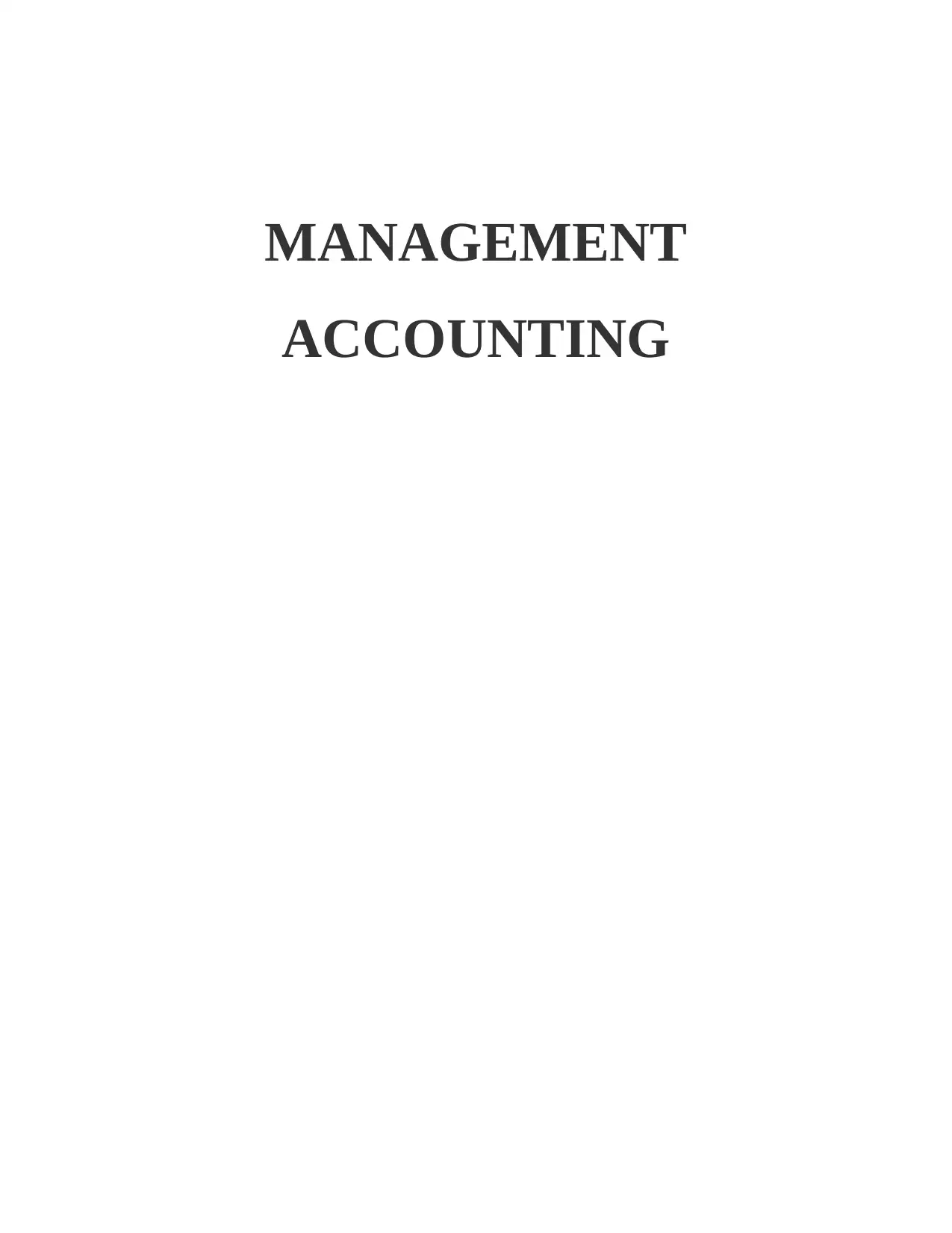
MANAGEMENT
ACCOUNTING
ACCOUNTING
Paraphrase This Document
Need a fresh take? Get an instant paraphrase of this document with our AI Paraphraser

TABLE OF CONTENTS
INTRODUCTION...........................................................................................................................1
Range of management accounting techniques.............................................................................1
Microeconomic techniques..........................................................................................................1
Product costing............................................................................................................................2
Cost of Inventory.........................................................................................................................3
Use of planning tools in management accounting.......................................................................5
Using budgets for planning and control.......................................................................................5
Pricing..........................................................................................................................................6
Common costing systems............................................................................................................7
Strategic Planning........................................................................................................................8
Organisations responding to financial problems.........................................................................8
Identification of financial problems.............................................................................................8
Financial governance...................................................................................................................9
Characteristics of an effective management accountant..............................................................9
Effective strategies and systems..................................................................................................9
CONCLUSION..............................................................................................................................10
REFERENCES..............................................................................................................................11
INTRODUCTION...........................................................................................................................1
Range of management accounting techniques.............................................................................1
Microeconomic techniques..........................................................................................................1
Product costing............................................................................................................................2
Cost of Inventory.........................................................................................................................3
Use of planning tools in management accounting.......................................................................5
Using budgets for planning and control.......................................................................................5
Pricing..........................................................................................................................................6
Common costing systems............................................................................................................7
Strategic Planning........................................................................................................................8
Organisations responding to financial problems.........................................................................8
Identification of financial problems.............................................................................................8
Financial governance...................................................................................................................9
Characteristics of an effective management accountant..............................................................9
Effective strategies and systems..................................................................................................9
CONCLUSION..............................................................................................................................10
REFERENCES..............................................................................................................................11

INTRODUCTION
The file is about management accounting, its concepts, uses and analysis. Management
accounting is accounting used by managers for making business decisions. It covers concept of
costs, inventory valuation, planning tools used in management accounting and ways in which
organisations respond to financial problems.
Range of management accounting techniques
Microeconomic techniques
Cost: Costs can be said as the expenses which a business incurs in production of goods,
administration expenses and services and is composed of fixed and variable costs. Fixed costs
can be on the assets, land and machinery of the organization. Variable costs are those which
keep on changing like variable commission etc.
Different costs and analysis
Fixed costs: The costs which doesn't varies with changing output. The costs include building,
factory, legal and insurance etc. They can be maintenance costs which are fixed monthly for
machinery servicing (Rikhardsson and Yigitbasioglu, 2018).
Variable costs: These costs are those which depend on the output produced. For e.g.: use of raw
materials, it can be more or less. The examples of variable costs are raw materials, labour costs,
IT fees and taxes.
Cost volume profit analysis is method of accounting of costs that analyse the varying levels of
costs and volume have on an operating profit. The cost-volume profit analysis is also known as
break-even analysis.
1
The file is about management accounting, its concepts, uses and analysis. Management
accounting is accounting used by managers for making business decisions. It covers concept of
costs, inventory valuation, planning tools used in management accounting and ways in which
organisations respond to financial problems.
Range of management accounting techniques
Microeconomic techniques
Cost: Costs can be said as the expenses which a business incurs in production of goods,
administration expenses and services and is composed of fixed and variable costs. Fixed costs
can be on the assets, land and machinery of the organization. Variable costs are those which
keep on changing like variable commission etc.
Different costs and analysis
Fixed costs: The costs which doesn't varies with changing output. The costs include building,
factory, legal and insurance etc. They can be maintenance costs which are fixed monthly for
machinery servicing (Rikhardsson and Yigitbasioglu, 2018).
Variable costs: These costs are those which depend on the output produced. For e.g.: use of raw
materials, it can be more or less. The examples of variable costs are raw materials, labour costs,
IT fees and taxes.
Cost volume profit analysis is method of accounting of costs that analyse the varying levels of
costs and volume have on an operating profit. The cost-volume profit analysis is also known as
break-even analysis.
1
⊘ This is a preview!⊘
Do you want full access?
Subscribe today to unlock all pages.

Trusted by 1+ million students worldwide
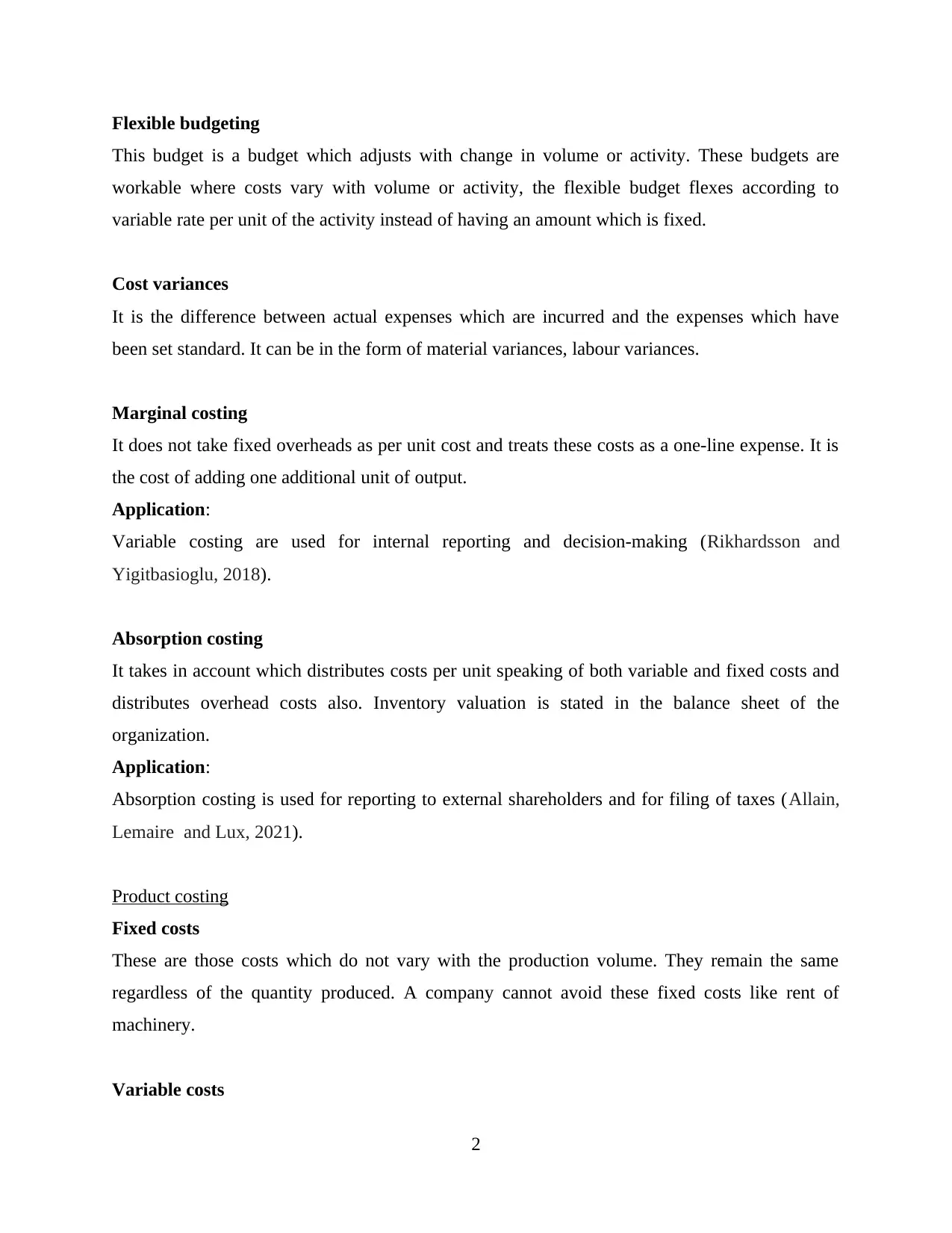
Flexible budgeting
This budget is a budget which adjusts with change in volume or activity. These budgets are
workable where costs vary with volume or activity, the flexible budget flexes according to
variable rate per unit of the activity instead of having an amount which is fixed.
Cost variances
It is the difference between actual expenses which are incurred and the expenses which have
been set standard. It can be in the form of material variances, labour variances.
Marginal costing
It does not take fixed overheads as per unit cost and treats these costs as a one-line expense. It is
the cost of adding one additional unit of output.
Application:
Variable costing are used for internal reporting and decision-making (Rikhardsson and
Yigitbasioglu, 2018).
Absorption costing
It takes in account which distributes costs per unit speaking of both variable and fixed costs and
distributes overhead costs also. Inventory valuation is stated in the balance sheet of the
organization.
Application:
Absorption costing is used for reporting to external shareholders and for filing of taxes (Allain,
Lemaire and Lux, 2021).
Product costing
Fixed costs
These are those costs which do not vary with the production volume. They remain the same
regardless of the quantity produced. A company cannot avoid these fixed costs like rent of
machinery.
Variable costs
2
This budget is a budget which adjusts with change in volume or activity. These budgets are
workable where costs vary with volume or activity, the flexible budget flexes according to
variable rate per unit of the activity instead of having an amount which is fixed.
Cost variances
It is the difference between actual expenses which are incurred and the expenses which have
been set standard. It can be in the form of material variances, labour variances.
Marginal costing
It does not take fixed overheads as per unit cost and treats these costs as a one-line expense. It is
the cost of adding one additional unit of output.
Application:
Variable costing are used for internal reporting and decision-making (Rikhardsson and
Yigitbasioglu, 2018).
Absorption costing
It takes in account which distributes costs per unit speaking of both variable and fixed costs and
distributes overhead costs also. Inventory valuation is stated in the balance sheet of the
organization.
Application:
Absorption costing is used for reporting to external shareholders and for filing of taxes (Allain,
Lemaire and Lux, 2021).
Product costing
Fixed costs
These are those costs which do not vary with the production volume. They remain the same
regardless of the quantity produced. A company cannot avoid these fixed costs like rent of
machinery.
Variable costs
2
Paraphrase This Document
Need a fresh take? Get an instant paraphrase of this document with our AI Paraphraser
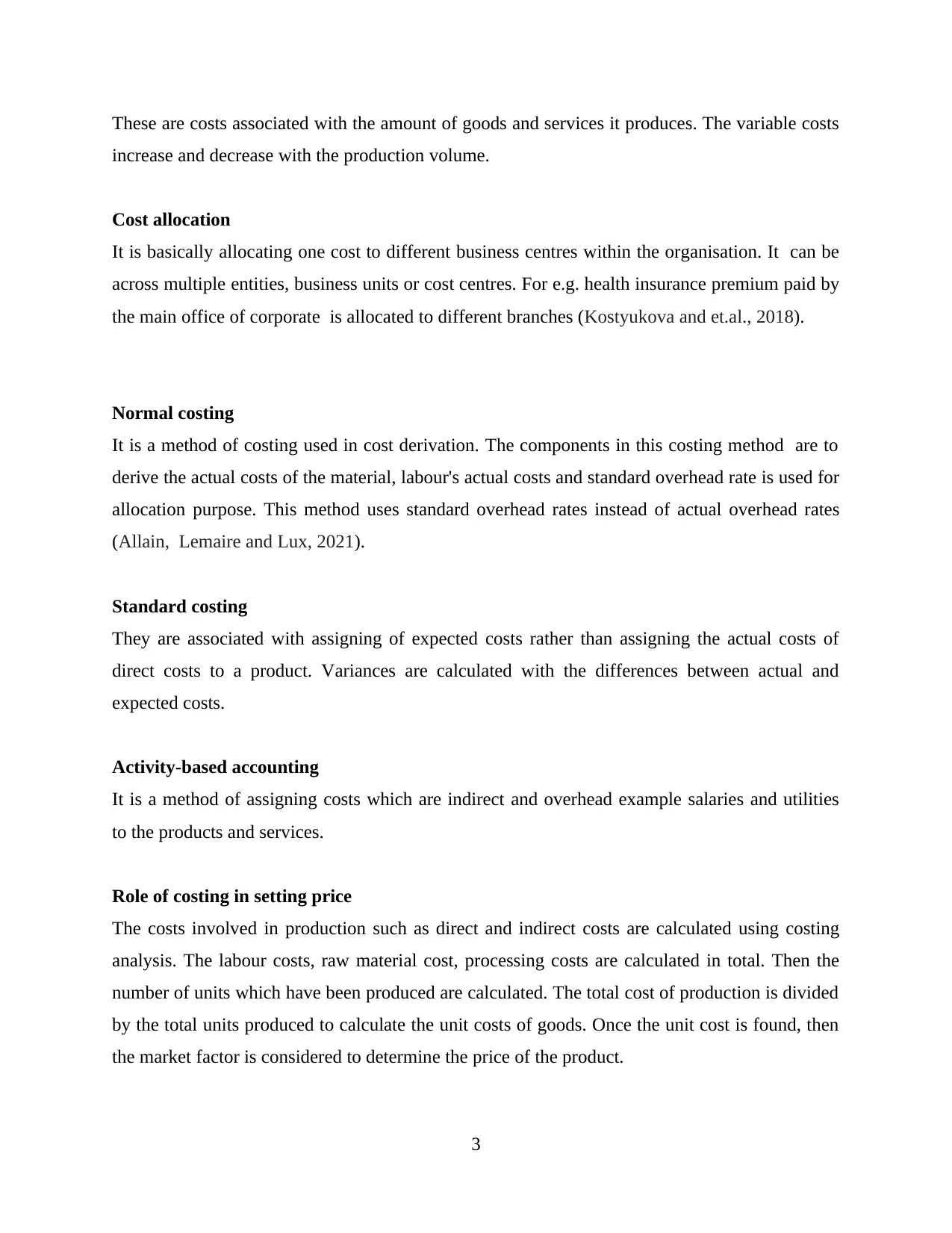
These are costs associated with the amount of goods and services it produces. The variable costs
increase and decrease with the production volume.
Cost allocation
It is basically allocating one cost to different business centres within the organisation. It can be
across multiple entities, business units or cost centres. For e.g. health insurance premium paid by
the main office of corporate is allocated to different branches (Kostyukova and et.al., 2018).
Normal costing
It is a method of costing used in cost derivation. The components in this costing method are to
derive the actual costs of the material, labour's actual costs and standard overhead rate is used for
allocation purpose. This method uses standard overhead rates instead of actual overhead rates
(Allain, Lemaire and Lux, 2021).
Standard costing
They are associated with assigning of expected costs rather than assigning the actual costs of
direct costs to a product. Variances are calculated with the differences between actual and
expected costs.
Activity-based accounting
It is a method of assigning costs which are indirect and overhead example salaries and utilities
to the products and services.
Role of costing in setting price
The costs involved in production such as direct and indirect costs are calculated using costing
analysis. The labour costs, raw material cost, processing costs are calculated in total. Then the
number of units which have been produced are calculated. The total cost of production is divided
by the total units produced to calculate the unit costs of goods. Once the unit cost is found, then
the market factor is considered to determine the price of the product.
3
increase and decrease with the production volume.
Cost allocation
It is basically allocating one cost to different business centres within the organisation. It can be
across multiple entities, business units or cost centres. For e.g. health insurance premium paid by
the main office of corporate is allocated to different branches (Kostyukova and et.al., 2018).
Normal costing
It is a method of costing used in cost derivation. The components in this costing method are to
derive the actual costs of the material, labour's actual costs and standard overhead rate is used for
allocation purpose. This method uses standard overhead rates instead of actual overhead rates
(Allain, Lemaire and Lux, 2021).
Standard costing
They are associated with assigning of expected costs rather than assigning the actual costs of
direct costs to a product. Variances are calculated with the differences between actual and
expected costs.
Activity-based accounting
It is a method of assigning costs which are indirect and overhead example salaries and utilities
to the products and services.
Role of costing in setting price
The costs involved in production such as direct and indirect costs are calculated using costing
analysis. The labour costs, raw material cost, processing costs are calculated in total. Then the
number of units which have been produced are calculated. The total cost of production is divided
by the total units produced to calculate the unit costs of goods. Once the unit cost is found, then
the market factor is considered to determine the price of the product.
3

Cost of Inventory
Inventory costs
They are the costs which go in ordering and holding inventory along with administering the
paper work. The cost is examined as part of the valuation of the quantity to be kept in store.
Inventory costs can be classified as below:
Ordering costs
These costs include the procurement department costs which includes wages and related payroll
taxes.
Holding costs
These costs relate to the storage costs of the inventory and cost needed to acquire the inventory.
These costs include:
a) Cost of space: The storage facility costs which include warehouse depreciation, maintenance
costs, storage racks etc. are included in this cost (Simeon and John, 2018).
b) Cost of money: This is an interest cost which is associated with funds to pay for the inventory.
c) Cost of obsolescence: The inventory items which get damaged while in storage have to be
disposed of at reduced price.
Administrative costs
The costs which come under administrative costs can be classified as building, rent, lease,
utilities etc.
Benefits of reducing inventory costs
The inventory costs reduction will mean company is left with more finance which can be
utilised in other departments. The costs can get reduced with company following an approach of
just-in-time inventory in which company orders the right inventory amount and the economic
order quantity which can reduce inventory costs. This will help reduce the ordering costs of
inventory, purchasing cost, the cost of labour, cost of maintenance, the cost of paying for
damaged goods etc. This will help save company finance and use them in daily operations.
4
Inventory costs
They are the costs which go in ordering and holding inventory along with administering the
paper work. The cost is examined as part of the valuation of the quantity to be kept in store.
Inventory costs can be classified as below:
Ordering costs
These costs include the procurement department costs which includes wages and related payroll
taxes.
Holding costs
These costs relate to the storage costs of the inventory and cost needed to acquire the inventory.
These costs include:
a) Cost of space: The storage facility costs which include warehouse depreciation, maintenance
costs, storage racks etc. are included in this cost (Simeon and John, 2018).
b) Cost of money: This is an interest cost which is associated with funds to pay for the inventory.
c) Cost of obsolescence: The inventory items which get damaged while in storage have to be
disposed of at reduced price.
Administrative costs
The costs which come under administrative costs can be classified as building, rent, lease,
utilities etc.
Benefits of reducing inventory costs
The inventory costs reduction will mean company is left with more finance which can be
utilised in other departments. The costs can get reduced with company following an approach of
just-in-time inventory in which company orders the right inventory amount and the economic
order quantity which can reduce inventory costs. This will help reduce the ordering costs of
inventory, purchasing cost, the cost of labour, cost of maintenance, the cost of paying for
damaged goods etc. This will help save company finance and use them in daily operations.
4
⊘ This is a preview!⊘
Do you want full access?
Subscribe today to unlock all pages.

Trusted by 1+ million students worldwide
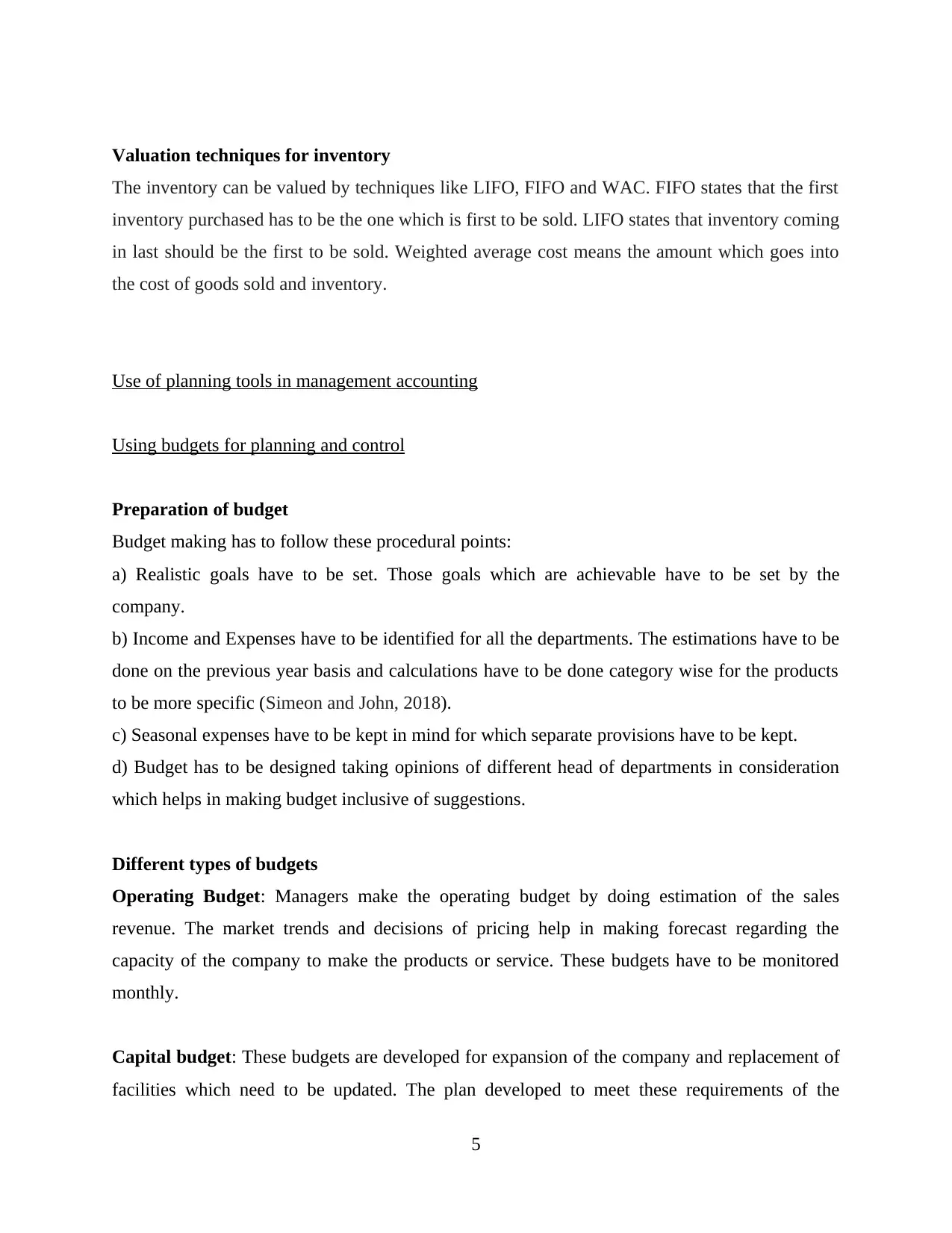
Valuation techniques for inventory
The inventory can be valued by techniques like LIFO, FIFO and WAC. FIFO states that the first
inventory purchased has to be the one which is first to be sold. LIFO states that inventory coming
in last should be the first to be sold. Weighted average cost means the amount which goes into
the cost of goods sold and inventory.
Use of planning tools in management accounting
Using budgets for planning and control
Preparation of budget
Budget making has to follow these procedural points:
a) Realistic goals have to be set. Those goals which are achievable have to be set by the
company.
b) Income and Expenses have to be identified for all the departments. The estimations have to be
done on the previous year basis and calculations have to be done category wise for the products
to be more specific (Simeon and John, 2018).
c) Seasonal expenses have to be kept in mind for which separate provisions have to be kept.
d) Budget has to be designed taking opinions of different head of departments in consideration
which helps in making budget inclusive of suggestions.
Different types of budgets
Operating Budget: Managers make the operating budget by doing estimation of the sales
revenue. The market trends and decisions of pricing help in making forecast regarding the
capacity of the company to make the products or service. These budgets have to be monitored
monthly.
Capital budget: These budgets are developed for expansion of the company and replacement of
facilities which need to be updated. The plan developed to meet these requirements of the
5
The inventory can be valued by techniques like LIFO, FIFO and WAC. FIFO states that the first
inventory purchased has to be the one which is first to be sold. LIFO states that inventory coming
in last should be the first to be sold. Weighted average cost means the amount which goes into
the cost of goods sold and inventory.
Use of planning tools in management accounting
Using budgets for planning and control
Preparation of budget
Budget making has to follow these procedural points:
a) Realistic goals have to be set. Those goals which are achievable have to be set by the
company.
b) Income and Expenses have to be identified for all the departments. The estimations have to be
done on the previous year basis and calculations have to be done category wise for the products
to be more specific (Simeon and John, 2018).
c) Seasonal expenses have to be kept in mind for which separate provisions have to be kept.
d) Budget has to be designed taking opinions of different head of departments in consideration
which helps in making budget inclusive of suggestions.
Different types of budgets
Operating Budget: Managers make the operating budget by doing estimation of the sales
revenue. The market trends and decisions of pricing help in making forecast regarding the
capacity of the company to make the products or service. These budgets have to be monitored
monthly.
Capital budget: These budgets are developed for expansion of the company and replacement of
facilities which need to be updated. The plan developed to meet these requirements of the
5
Paraphrase This Document
Need a fresh take? Get an instant paraphrase of this document with our AI Paraphraser

company comes under the capital budget. Successful companies evaluate the conditions of
market and see opportunities for expansion. Talking of facilities being worn out, the machinery
needs to be replaced or changes made.
The alternative forms of budget are:
a) Traditional form of budgeting: The form emphasises on the budgeting which makes budget
according to the estimations done on the previous years financials.
b) Zero based Budgeting: This form of budgeting does the product wise and category wise
evaluation of expenses for each department category wise and separately demands are projected
line wise.
Behavioural implications of budgets
a) It can promote dysfunctional behaviour in which some managers will be happy to receive
budget as per their demands for the department while some managers would be feeling left out as
they could not get sufficient budget as per requirements and this results into a dissatisfaction
(Chouhan, Soral and Chandra, 2017).
b) Making of budget can be participative if it is done in an open-ended way by incorporating
suggestions of managers, subordinates, employees.
Pricing
Pricing strategies
The forms of pricing strategies can be defined as below:
a) Absorption pricing: This pricing strategy includes all the variable costs as well as
direct costs in proportion to the product.
b) Premium pricing: The practice of setting a high price to give it an impression that product
will be of high quality. This is usually done to segment a customer range which buys products of
high price.
Competitors determine their prices by using cost analysis in which the production costs of the
company are determined and then a profit margin is set by the company after taking out price per
unit. The competitors then do a market research of how the products of same category have been
6
market and see opportunities for expansion. Talking of facilities being worn out, the machinery
needs to be replaced or changes made.
The alternative forms of budget are:
a) Traditional form of budgeting: The form emphasises on the budgeting which makes budget
according to the estimations done on the previous years financials.
b) Zero based Budgeting: This form of budgeting does the product wise and category wise
evaluation of expenses for each department category wise and separately demands are projected
line wise.
Behavioural implications of budgets
a) It can promote dysfunctional behaviour in which some managers will be happy to receive
budget as per their demands for the department while some managers would be feeling left out as
they could not get sufficient budget as per requirements and this results into a dissatisfaction
(Chouhan, Soral and Chandra, 2017).
b) Making of budget can be participative if it is done in an open-ended way by incorporating
suggestions of managers, subordinates, employees.
Pricing
Pricing strategies
The forms of pricing strategies can be defined as below:
a) Absorption pricing: This pricing strategy includes all the variable costs as well as
direct costs in proportion to the product.
b) Premium pricing: The practice of setting a high price to give it an impression that product
will be of high quality. This is usually done to segment a customer range which buys products of
high price.
Competitors determine their prices by using cost analysis in which the production costs of the
company are determined and then a profit margin is set by the company after taking out price per
unit. The competitors then do a market research of how the products of same category have been
6
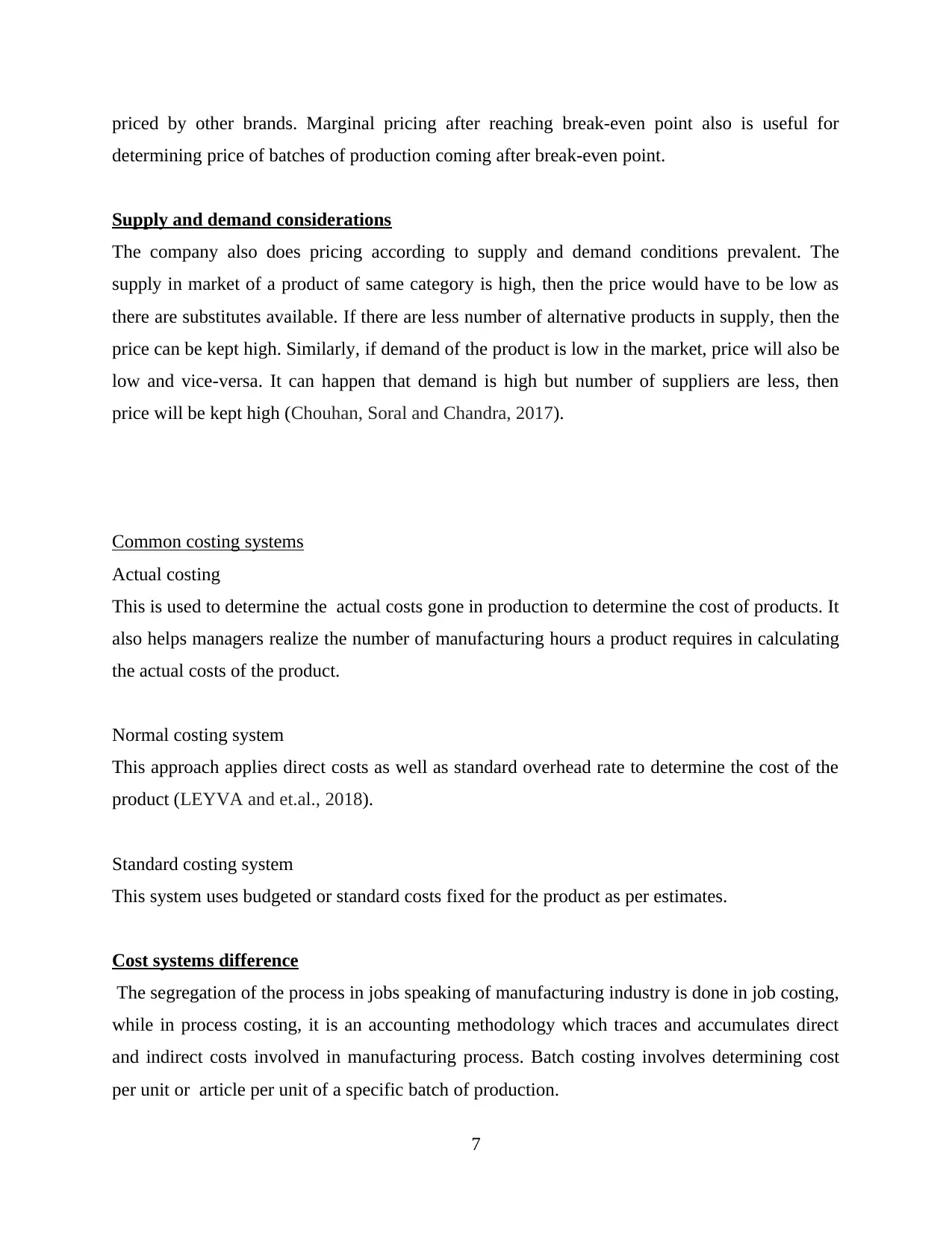
priced by other brands. Marginal pricing after reaching break-even point also is useful for
determining price of batches of production coming after break-even point.
Supply and demand considerations
The company also does pricing according to supply and demand conditions prevalent. The
supply in market of a product of same category is high, then the price would have to be low as
there are substitutes available. If there are less number of alternative products in supply, then the
price can be kept high. Similarly, if demand of the product is low in the market, price will also be
low and vice-versa. It can happen that demand is high but number of suppliers are less, then
price will be kept high (Chouhan, Soral and Chandra, 2017).
Common costing systems
Actual costing
This is used to determine the actual costs gone in production to determine the cost of products. It
also helps managers realize the number of manufacturing hours a product requires in calculating
the actual costs of the product.
Normal costing system
This approach applies direct costs as well as standard overhead rate to determine the cost of the
product (LEYVA and et.al., 2018).
Standard costing system
This system uses budgeted or standard costs fixed for the product as per estimates.
Cost systems difference
The segregation of the process in jobs speaking of manufacturing industry is done in job costing,
while in process costing, it is an accounting methodology which traces and accumulates direct
and indirect costs involved in manufacturing process. Batch costing involves determining cost
per unit or article per unit of a specific batch of production.
7
determining price of batches of production coming after break-even point.
Supply and demand considerations
The company also does pricing according to supply and demand conditions prevalent. The
supply in market of a product of same category is high, then the price would have to be low as
there are substitutes available. If there are less number of alternative products in supply, then the
price can be kept high. Similarly, if demand of the product is low in the market, price will also be
low and vice-versa. It can happen that demand is high but number of suppliers are less, then
price will be kept high (Chouhan, Soral and Chandra, 2017).
Common costing systems
Actual costing
This is used to determine the actual costs gone in production to determine the cost of products. It
also helps managers realize the number of manufacturing hours a product requires in calculating
the actual costs of the product.
Normal costing system
This approach applies direct costs as well as standard overhead rate to determine the cost of the
product (LEYVA and et.al., 2018).
Standard costing system
This system uses budgeted or standard costs fixed for the product as per estimates.
Cost systems difference
The segregation of the process in jobs speaking of manufacturing industry is done in job costing,
while in process costing, it is an accounting methodology which traces and accumulates direct
and indirect costs involved in manufacturing process. Batch costing involves determining cost
per unit or article per unit of a specific batch of production.
7
⊘ This is a preview!⊘
Do you want full access?
Subscribe today to unlock all pages.

Trusted by 1+ million students worldwide

Strategic Planning
PEST analysis of Prime furniture
Political: The company being in UK has to face tariffs higher than earlier after the UK Brexit.
The changing governments can also have an influence on the company's business and finance
policy. Government's initiative can also help the company in getting loans for the company.
Economic: The economic factors like country's current situation can affect adversely on the
company's business. In the current situation, where there is a slowdown in trade activities,
company has to focus more on domestic market rather than exports.
Social: The social factors like customers ordering in bulk can be a good sign if furniture orders
are given more in all forms to the company. Company has to gear up the production accordingly
to meet the needs of customers.
Technological: The technical factors like use of online selling of products and online ordering
can boost company's revenue with a small investment in e-commerce (LEYVA and et.al., 2018).
Organisations responding to financial problems
Identification of financial problems
Key performance indicators and budget targets for identifying variances
Operating cash flow: It represents the total amount of capital which is gained by daily operations.
It alerts management whether the business has adequate funds to continue operations.
Current ratio: This ratio helps determine the solvency of the company whether it has sufficient
current assets to take care of the current liabilities. This also is an indicator of whether the
company has sufficient working capital (Bui and De Villiers, 2017).
Expenses vs budget: The actual expenses are compared with the budget stand as KPI. This helps
in knowing the department wise deviation from the budget whether favourable or unfavourable.
8
PEST analysis of Prime furniture
Political: The company being in UK has to face tariffs higher than earlier after the UK Brexit.
The changing governments can also have an influence on the company's business and finance
policy. Government's initiative can also help the company in getting loans for the company.
Economic: The economic factors like country's current situation can affect adversely on the
company's business. In the current situation, where there is a slowdown in trade activities,
company has to focus more on domestic market rather than exports.
Social: The social factors like customers ordering in bulk can be a good sign if furniture orders
are given more in all forms to the company. Company has to gear up the production accordingly
to meet the needs of customers.
Technological: The technical factors like use of online selling of products and online ordering
can boost company's revenue with a small investment in e-commerce (LEYVA and et.al., 2018).
Organisations responding to financial problems
Identification of financial problems
Key performance indicators and budget targets for identifying variances
Operating cash flow: It represents the total amount of capital which is gained by daily operations.
It alerts management whether the business has adequate funds to continue operations.
Current ratio: This ratio helps determine the solvency of the company whether it has sufficient
current assets to take care of the current liabilities. This also is an indicator of whether the
company has sufficient working capital (Bui and De Villiers, 2017).
Expenses vs budget: The actual expenses are compared with the budget stand as KPI. This helps
in knowing the department wise deviation from the budget whether favourable or unfavourable.
8
Paraphrase This Document
Need a fresh take? Get an instant paraphrase of this document with our AI Paraphraser
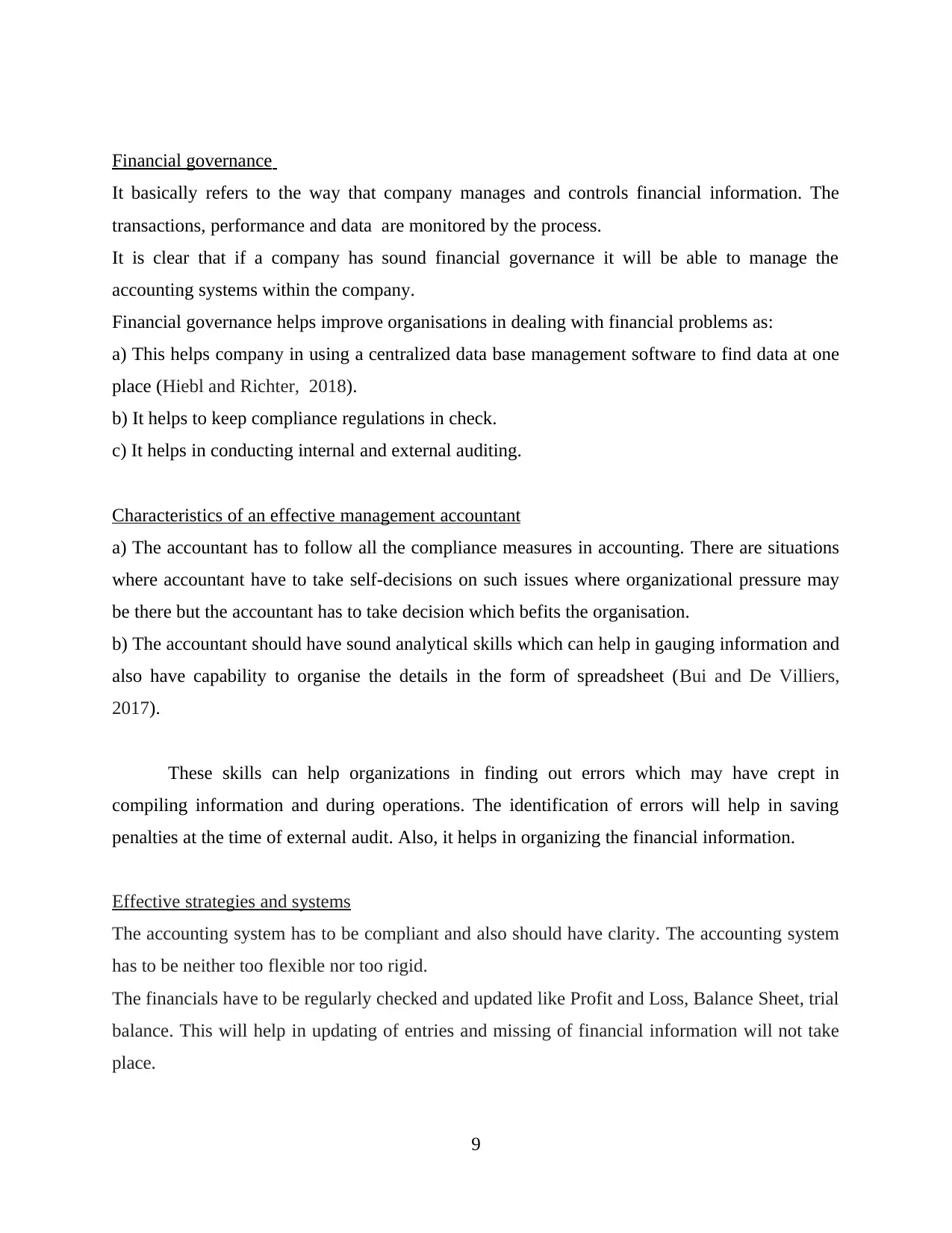
Financial governance
It basically refers to the way that company manages and controls financial information. The
transactions, performance and data are monitored by the process.
It is clear that if a company has sound financial governance it will be able to manage the
accounting systems within the company.
Financial governance helps improve organisations in dealing with financial problems as:
a) This helps company in using a centralized data base management software to find data at one
place (Hiebl and Richter, 2018).
b) It helps to keep compliance regulations in check.
c) It helps in conducting internal and external auditing.
Characteristics of an effective management accountant
a) The accountant has to follow all the compliance measures in accounting. There are situations
where accountant have to take self-decisions on such issues where organizational pressure may
be there but the accountant has to take decision which befits the organisation.
b) The accountant should have sound analytical skills which can help in gauging information and
also have capability to organise the details in the form of spreadsheet (Bui and De Villiers,
2017).
These skills can help organizations in finding out errors which may have crept in
compiling information and during operations. The identification of errors will help in saving
penalties at the time of external audit. Also, it helps in organizing the financial information.
Effective strategies and systems
The accounting system has to be compliant and also should have clarity. The accounting system
has to be neither too flexible nor too rigid.
The financials have to be regularly checked and updated like Profit and Loss, Balance Sheet, trial
balance. This will help in updating of entries and missing of financial information will not take
place.
9
It basically refers to the way that company manages and controls financial information. The
transactions, performance and data are monitored by the process.
It is clear that if a company has sound financial governance it will be able to manage the
accounting systems within the company.
Financial governance helps improve organisations in dealing with financial problems as:
a) This helps company in using a centralized data base management software to find data at one
place (Hiebl and Richter, 2018).
b) It helps to keep compliance regulations in check.
c) It helps in conducting internal and external auditing.
Characteristics of an effective management accountant
a) The accountant has to follow all the compliance measures in accounting. There are situations
where accountant have to take self-decisions on such issues where organizational pressure may
be there but the accountant has to take decision which befits the organisation.
b) The accountant should have sound analytical skills which can help in gauging information and
also have capability to organise the details in the form of spreadsheet (Bui and De Villiers,
2017).
These skills can help organizations in finding out errors which may have crept in
compiling information and during operations. The identification of errors will help in saving
penalties at the time of external audit. Also, it helps in organizing the financial information.
Effective strategies and systems
The accounting system has to be compliant and also should have clarity. The accounting system
has to be neither too flexible nor too rigid.
The financials have to be regularly checked and updated like Profit and Loss, Balance Sheet, trial
balance. This will help in updating of entries and missing of financial information will not take
place.
9
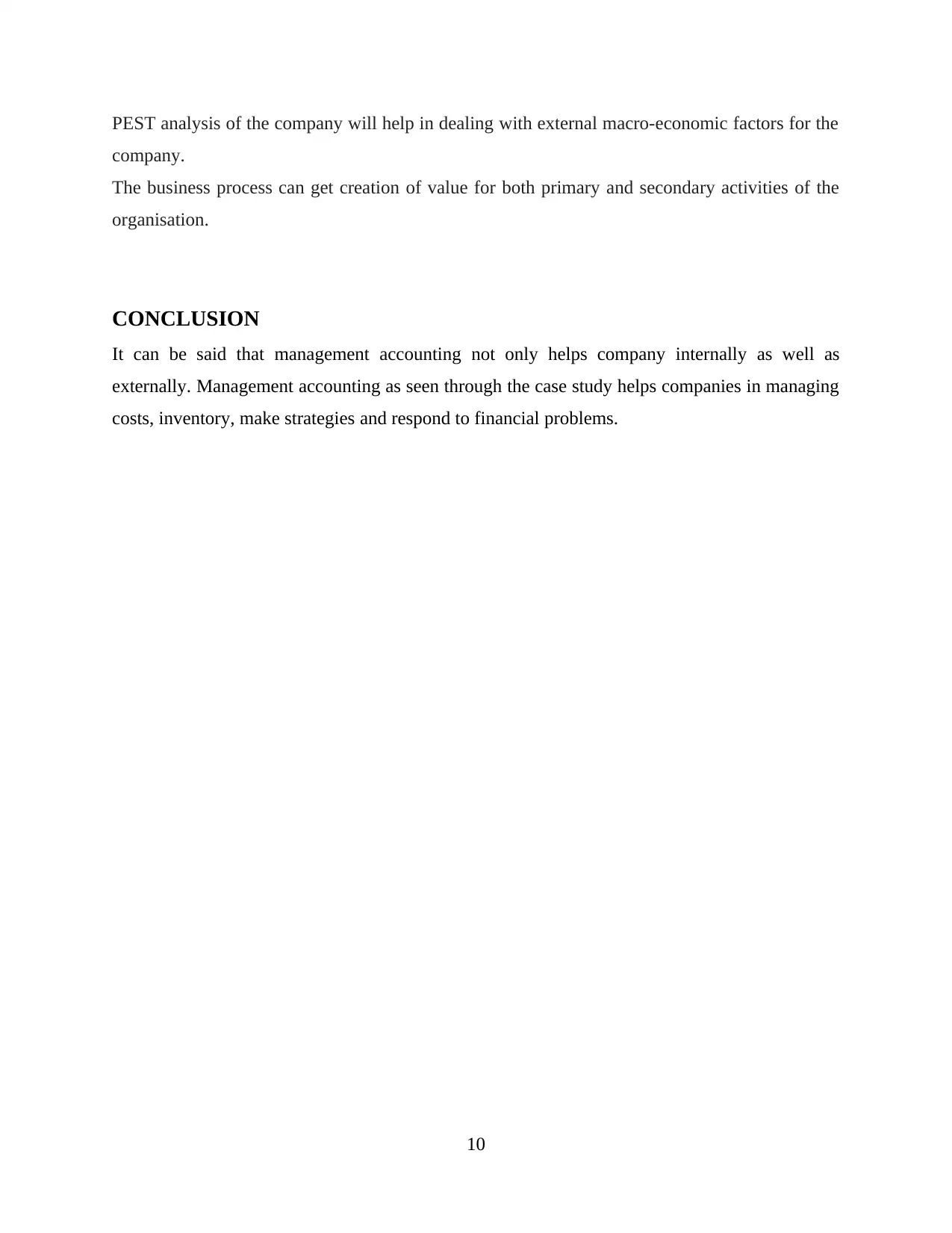
PEST analysis of the company will help in dealing with external macro-economic factors for the
company.
The business process can get creation of value for both primary and secondary activities of the
organisation.
CONCLUSION
It can be said that management accounting not only helps company internally as well as
externally. Management accounting as seen through the case study helps companies in managing
costs, inventory, make strategies and respond to financial problems.
10
company.
The business process can get creation of value for both primary and secondary activities of the
organisation.
CONCLUSION
It can be said that management accounting not only helps company internally as well as
externally. Management accounting as seen through the case study helps companies in managing
costs, inventory, make strategies and respond to financial problems.
10
⊘ This is a preview!⊘
Do you want full access?
Subscribe today to unlock all pages.

Trusted by 1+ million students worldwide
1 out of 17
Related Documents
Your All-in-One AI-Powered Toolkit for Academic Success.
+13062052269
info@desklib.com
Available 24*7 on WhatsApp / Email
![[object Object]](/_next/static/media/star-bottom.7253800d.svg)
Unlock your academic potential
Copyright © 2020–2025 A2Z Services. All Rights Reserved. Developed and managed by ZUCOL.





